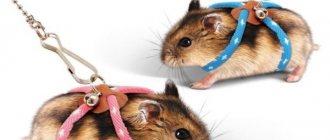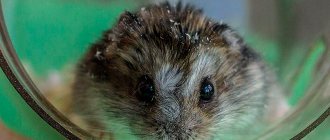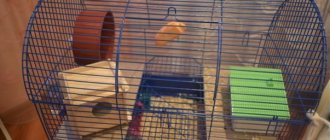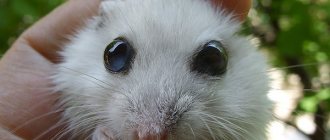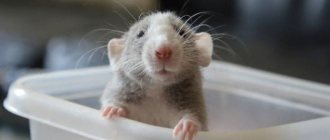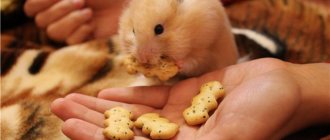Cute fluffy hamsters are very active and inquisitive animals. During periods of activity, funny Syrian and Djungarian hamsters can scurry around in their cage for hours, run along stairs and tunnels, and play in the hands of their owners. Sometimes you can notice that the hamster's hind legs have failed. This disease can occur in pets at any age, even with the best care.
Why can hamsters' paws fail?
There are a huge number of reasons why your beloved pet may have lost its hind legs:
Insufficient physical activity
When rodents are kept in small cages and there are no devices for animal play in them, hamsters experience a decrease in activity and the development of obesity. Lack of exercise and a sedentary lifestyle cause bone tissue destruction and muscle atrophy, as a result the hamster becomes lethargic, drags its hind legs, and some individuals lose the ability to move. To prevent the development of obesity, it is necessary to keep animals in spacious cages, provide them with accessories for physical activity and a balanced diet.
Injuries
The hind limbs can become paralyzed after a hamster falls from even a small height.
The baby can jump out of the owner’s hands onto the floor or from the top floor of the cage, damage its paw on the grated floor or stairs, the consequences of these accidents are dislocations and fractures of the spine and limbs, bruises of internal organs and internal hemorrhages.
After damage, it is recommended to limit the mobility of your furry pet as much as possible, remove all toys, tunnels, ladders, and wheels from the cage. It is best to place the animal in an aquarium or container for 2-3 weeks; crushed ordinary white napkins can be used as filler. It is necessary to feed the hamster with foods containing calcium: low-fat cottage cheese, kefir or yogurt, lettuce, boiled eggs. It is advisable to show the animal to a veterinarian. To avoid injuries, it is necessary to remove all floors in the cage and carefully monitor the pet when it is in your hands, on the sofa, or table.
Stress
Sudden paralysis of the hind limbs can develop in Djungarians as a result of a stroke or heart attack against the background of severe stress, which can be caused by sharp screams, blows, being chased by a dog or cat, intrusiveness of owners and insufficient care. In case of severe fright, instant death of the pet is possible. In case of paralysis of the hind legs, it is necessary to create a comfortable, calm environment for the baby with good nutrition, change the bedding frequently, do not force feed the hamster, do not force a small rodent to play, and exclude sharp sounds and communication with other pets. To prevent stressful situations, it is necessary to create a cozy environment for your pet with a clean cage, good nutrition and the absence of harsh sounds and intrusiveness from children and animals.
Elderly age
Hamsters of advanced age sometimes experience paralysis of the hind limbs. You may also notice that the old rodent's legs tremble in its sleep. Such neurological manifestations are associated with age and indicate the imminent death of the pet. It is necessary on your part to provide your furry friend with care and proper care.
Diseases
Infectious, oncological, inflammatory diseases of internal organs and hernias can cause paralysis of your pet’s hind legs. In addition, lethargy, lack of appetite, tousled fur, dirty genitals and a wet tail may be observed. To clarify the diagnosis, find out the cause and prescribe effective treatment in such cases, it is necessary to urgently take the animal to a specialist or call a doctor at home. In hamsters, pathological processes develop rapidly; the course and outcome of the disease depend on the timeliness of seeking medical attention and the initiation of therapy.
Love your cute fluffies, avoid injuries and stress; if paralysis of the hind legs occurs, try to contact a veterinary clinic as soon as possible. Most often, the baby can be cured and provided with a carefree and happy life.
Sometimes owners may see an unusual picture: the hamster falls on its back, somersaults over its head, and a second later finds itself on all fours and continues its usual activities. Of course, this behavior alarms caring and attentive owners, as it may indicate the development of a disease.
To understand whether it is worth contacting a veterinarian in this case, you need to understand the physiological and pathological causes of the condition in which hamsters fall on their back.
- Why does a hamster fall on its back?
- Pet needs a sand bath
- Defensive stance
- Falling from height
- The pet is sick
A hamster broke its leg - what to do, how to understand and provide assistance in case of injury
Suspicion of a broken limb in a tiny animal often causes panic among owners.
After all, it is completely unclear how to help the animal, what to do with a tiny paw and how to limit the mobility of an unreasonable pet.
If you consider that hamsters are very often kept for children, then you won’t envy adults at all. However, not everything is so scary and in most cases the owners are quite capable of helping their pet.
A hamster can have a closed fracture as well as an open one.
How can you tell if your paw is broken?
Even animals that do not leave their cage often suffer bruises, sprains and dislocations. Often these types of injuries go unnoticed because the animal in pain reduces physical activity and hides in its house until the discomfort passes. The fracture can be open or closed:
Closed fracture
- the limb hangs unnaturally;
- the animal moves on three limbs, pressing the injured paw to the body;
- the injured paw is swollen and there is noticeable bleeding;
- the hamster tries to move as little as possible and refuses food.
IMPORTANT: You should not palpate a rodent's paw to diagnose a fracture, since the hamster's bones are too thin for a fracture to be detected by palpation. This will aggravate the injury and cause unnecessary suffering to the animal. If possible, it is recommended to take an X-ray to make a final diagnosis.
A closed fracture is often confused with a dislocation. A modern digital device is able to detect fractures in even the smallest animals
If possible, it is recommended to take an X-ray to make a final diagnosis. A closed fracture is often confused with a dislocation. A modern digital device is capable of detecting fractures in even the smallest animals.
Limited mobility
First of all, even before consulting a veterinarian, you need to limit your pet’s mobility as much as possible. To do this, place it in a bowl or container where a drinking bowl and feeder will fit, but there will be little room for movement. Place plain paper on the bottom - hamsters don’t like to stir it up.
Have you already taken your hamster to the vet?
How to feed a hamster with a fracture?
The most important rule for feeding an injured animal is moderation and lack of experimentation with food. It is better to reduce the amount of food a little
It is especially important not to allow your hamster to stuff food into its cheeks if its front leg is broken, as the animal may damage it further in the process.
It is best to give a grain mixture in a small bowl, green leaves and vegetables. Insect larvae, cottage cheese and kefir can be given in microscopic doses, provided that they were included in the hamster’s diet before.
There is a chance of getting purulent inflammation
Keeping the cage clean
Cleaning a cage with a sick animal should be done very often, at least once, and preferably twice a day. Completely replace the bedding (use plain paper instead of sawdust), change the water in the drinking bowl, immediately after feeding, remove the remaining food from the feeder so that the hamster does not stock up.
A sick animal needs to change its diet
Veterinary assistance
It is best to show the animal to a specialized specialist immediately after discovering a fracture. It is best to visit a doctor who specializes in rodents - a ratologist.
The veterinarian may prescribe pain medication for 1-3 days. If you managed to get to the doctor a few days after the injury and the wound has already festered, you may need injections of an antibiotic: Baytril, Enroxil or regular human bicillin-3 diluted with water for injection.
If a doctor recommends amputation of a limb, the owner had better agree. It will be performed under general anesthesia, and the stump will heal quite quickly. The animal’s quality of life will not suffer too much; they are quite well adapted to move on three or even two legs.
Limb injuries heal quickly
Conclusion
A broken limb of a beloved animal is often a shock to the owner, but quality care and timely treatment will help the hamster recover quickly and live a long, fulfilling life.
Why does a hamster fall on its back?
If your pet maintains mobility, appetite and cheerfulness, then there is no need to worry. However, if the hamster falls down as if paralyzed, pulls its hind legs, becomes lethargic and apathetic, then you should immediately contact a veterinary clinic.
There are physiological and pathological reasons for this behavior. To determine them, you need to carefully monitor the accompanying symptoms and the general condition of the hamster.
Pet needs a sand bath
In the wild, hamsters use sand baths to combat parasites. The rodents fall on their backs, somersault, quickly jump up, and then repeat everything again.
Pets do the same on an instinctive level. Therefore, if the hamster begins to tumble backwards, then it is worth offering him a bath of fine, purified sand.
Defensive stance
The reason a hamster falls on its back may be a defensive reaction. No matter how strange it may seem, the defensive stance of a rodent is characterized by:
- falling on your back;
- freezing in this position for several seconds;
- pressing ears tightly;
- raising all four paws up.
This pose shows that the animal is belligerent. Therefore, you should not disturb him - at this moment he may bite or scratch severely.
Falling from height
A hamster's hind legs may fail due to injury from a fall from a height onto its back. In this case, severe bruises, dislocations, fractures of bones and the spinal column may occur, hematomas may form, compressing muscles and nerve endings.
Note! After a fall, the hamster can lie on its back for a short time, as if sleeping. This behavior is a reaction to stress. If the rodent soon turns over and returns to normal activities, then there is no need to worry.
If the hamster's hind legs fail, you should try to limit the pet's mobility and inform the veterinarian about damage to the leg or spine. Subsequently, it is necessary to remove all ladders and crossbars from the cage, replace the bedding with soft paper napkins, and additionally introduce foods rich in calcium into the diet.
The pet is sick
A condition in which a hamster's hind legs suddenly fail may indicate a stroke or heart attack. These pathologies can be triggered by severe stress, which is caused by:
- loud sounds;
- sudden switching on of very bright light;
- the appearance of unfamiliar animals in the room;
- moving to a new place of residence;
- lack of attention from the owner or, conversely, his excessive intrusiveness.
Important! Severe fright can lead a hamster to sudden death.
Paralysis of the limbs, in which the hamster's hind legs give out and it falls on its back, can be the result of age-related changes. In most cases, this symptom indicates the approach of death.
Diseases that can cause hind leg failure in hamsters include:
- malignant tumors;
- inflammatory processes in internal organs;
- hernias;
- infections affecting nerve tissue.
In this case, the following symptoms also indicate the development of hamster pathologies:
- apathy;
- lack of interest in food;
- disheveled and unkempt fur;
- dirty genitals and tail.
If your hamster has any of the listed signs, you should immediately show your pet to a veterinarian. After all, pathological processes in rodents develop rapidly, and any delay can cost the animal its life.
Sometimes hamster owners note that the animal begins to step on some paw with caution. They immediately begin to panic, but it is better to calm down and analyze why the hamster is limping.
- Causes of lameness
- Types of injuries and symptoms
- Fractures
- Bruise or dislocation
- Wounds and cuts
- Therapeutic measures
- What to do after visiting a veterinary clinic?
Steps
Part 1
Assess the situation
- Examine the injured hamster.
The hamster's body is very small, and its bones are small and fragile, so these furry little ones often suffer various injuries. Fortunately, not in all cases you will need the help of a veterinarian. Quickly examine the injured animal and assess whether its injuries appear to be minor (such as minor cuts and scrapes) or severe (such as broken limbs or severe bleeding).
Call your veterinarian or veterinary clinic.
If your hamster is seriously injured, call your veterinarian or veterinary clinic immediately and let them know that you will soon be visiting them with an animal that will require urgent care. Keep in mind that not every pet doctor is trained in treating small pets (such as hamsters, mice, and guinea pigs). If your veterinary clinic doesn't have specialists who care for hamsters, ask if they can recommend a clinic or veterinarian who specializes in this group of pets.
- During your phone call, ask your veterinarian what first aid you can provide to your pet before you bring it to the clinic.
- Gather the necessary materials to assist.
If you determine that the injury does not pose a serious threat to the hamster's life, you can treat the animal on your own. To get started, gather all the materials you need for treatment, including clean towels, cotton swabs, several 10 ml syringes (without needles) and sterile gauze pads measuring 5x5 cm. In addition, you will need a bottle of sterile saline solution, wound cleaning solution ( You can buy Betadine, but a regular iodine solution) and antibiotic ointment will do.
Part 2
Treatment of small wounds on a hamster
- Give the hamster the opportunity to recover on its own.
- When you treat the wound yourself, it gives you the opportunity to prevent an abscess from forming. While cleaning the wound, you can control how well you cleaned it (which is difficult if your pet licks the wounds on his own).
Hamsters are very resilient animals, so small wounds in these animals heal quite quickly without any treatment. If your pet has minor cuts or scrapes, it is wise to leave the animal alone and allow it to fend for itself. In such cases, hamsters lick and clean their wounds, thereby promoting rapid healing.
Limit your hamster's mobility.
This will give you the opportunity to treat your pet's wounds. Before treating wounds, wrap your hamster in a small, clean towel to limit the animal's movement. An injured hamster becomes very restless, so you need to protect yourself from possible bites.
Treat the wound.
Take a syringe and fill it with some sterile saline solution. Carefully pour the solution onto the edges of the wound and blot the liquid using one or two gauze pads. Repeat the procedure several times to clean the wound and remove necrotic tissue.
Take a second syringe, fill it with a little iodine solution, pour it onto the surface of the wound, and then blot the solution with several gauze pads. Using a cotton swab, apply a thin layer of antibiotic ointment to the wound surface.
- An antiseptic helps destroy microorganisms that cause inflammation.
The iodine solution leaves stains on the skin that are difficult to wash off, so you may want to wear medical gloves before treating the wound.
Whatever injury your pet has suffered, it is important that he has the opportunity to rest and recover in the safe, quiet space of his crate. Place bowls of water and food near where your hamster usually sleeps. Find a warm, quiet place in the house for the cage where the hamster will not be disturbed.
Determine the cause of the injury.
Of course, you don't want your pet to get hurt again, so try to determine where exactly your pet got hurt this time. Look for any toys in the cage that have sharp edges that could cut the animal's skin. Carefully inspect the rods: perhaps there is a sharp end of the wire sticking out somewhere, on which your pet was scratched.
Part 3
First aid for serious injuries
- Provide first aid to the animal.
- Take care of the injured animal when you return home from the clinic.
Once your veterinarian has given your hamster the care it needs, there are a few things you'll need to do to give your hamster a calm environment to recover at home. In addition to painkillers, the doctor usually prescribes a cold compress, which should be applied to the injury site to reduce inflammation. Hamsters are very small animals, so an incorrectly applied cold compress can not only cool the injured area, but also cause general hypothermia in your pet.
- Wrap your hamster in a warm cloth while you apply the compress, and continue to warm your pet after the procedure is completed.
If your pet has an infected wound, your doctor will prescribe antibiotics, which you will need to give to your pet.
If your pet has been seriously injured,
you need
to take him to the vet as soon as possible. Providing first aid to your pet correctly will help stabilize its condition and increase the animal's chances of staying alive until it reaches the veterinarian's hands. First aid is extremely important if your hamster is bleeding.
Take the animal to the veterinary clinic.
The doctor will provide qualified assistance to your pet. When you take your hamster to the vet, wrap the animal in a towel and place it in its regular carrier. This will help provide a calm, safe environment for the animal during the trip.
Hamsters are one of the tiniest pets; they require special attention and timely care. With insufficient care, these pets are quite often susceptible to diseases, so the main task of the owner is to recognize the disease by symptoms, and begin treatment for their pet as early as possible and in a timely manner. Paws are the most vulnerable parts of the body of domestic rodents. They are quite often exposed not only to bruises and dislocations, but also to fractures. Animals most often injure their limbs during stress (the appearance of a cat or dog), during peak sexual activity, or during play. What to do if your hamster breaks his leg and how to help him cope with the injury?
The most common factors of injury among hamsters are:
- incorrect for a particular rodent species. When purchasing a hamster, take care of its complete safety. Choose reliable and safe cages. Sometimes the height of the cages can reach 70 centimeters, and it’s scary to imagine what a fall from such a huge height onto a plastic object, such as a feeder or house, would be like for a baby. And just the fact that the hamster broke its leg is not the worst thing. Sometimes the outcome for you may be more disastrous.
- entertainment and auxiliary accessories for the physical development of the pet. Buying “sports” and additional accessories - a lattice running wheel, all kinds of ladders and dividers between floors, into which your pets’ legs often fall. Try to purchase items that will ensure your pet's safety as much as possible.
We wrote in detail about how to set up a cage for your pet in.
By eliminating these causes, you can eliminate the possibility of some injuries. We all know that it is easier to prevent injury than to subsequently treat a furry rodent in pain.
Causes of lameness
The following reasons influence the occurrence of lameness in hamsters:
- Crowded home. For example, when keeping an animal in a jar. The muscles of hamsters that cannot move much and actively gradually atrophy.
- Inappropriate bedding. If you put cotton wool on your pet, this may limit its movements. The cotton wool wraps around his paws, squeezes them and hurts them. The pressure blocks blood flow to the muscles, leading to loss of motor function.
- Injury due to a fall. If you choose the wrong cage, the hamster will often get injured. For example, it is not advisable to buy two-story houses for small breeds. Hamsters are very active animals, so they can often fall while running.
- Careless handling. Most often, hamsters are purchased for children. Before buying, talk to your child and explain that you need to behave carefully with your pet. It cannot be thrown, grabbed sharply, or released from a great height. Teach your child to pick up the animal correctly. To do this, you need to place your hand with your palm up and wait until the fluffy climbs in on its own.
- Normal damage. Hamsters spend a lot of time moving, so they can get hurt or hit a wheel or ladder. Try to choose safe devices for games.
Increased ambient temperature
Small rodents, despite the fact that in the wild they can live in steppes, deserts and semi-deserts, do not tolerate heat well.
Prolonged exposure to high temperatures can lead to heat stroke.
Signs of this condition will be:
- Trembling when touched
- Convulsions
- Weakness and indifference
- Coordination of movements is impaired
- The hamster lies on its side and breathes heavily
Sudden overheating can lead to heart failure, which can be fatal. Such rodents do not have the body's natural protective functions in the form of sweat or mouth breathing.
If the animal is lethargic, but the exposure to high temperatures has not been for a long time, then the first aid will be to move it to a cooler room and spray cold water over it from a spray bottle.
A quick way to cool the body is to place the animal under a stream of cold water, holding the muzzle so that the hamster does not choke.
If the animal begins to come to life, it is important to give it water using a syringe or pipette.
In an unconscious state, the rodent will not be able to swallow liquid. To replenish the water-salt balance, a solution of sodium chloride or ringer is injected subcutaneously. Large breeds can be injected from four to eight milliliters, dwarf and Djungarian hamsters - two milliliters.
Hamsters are one of the tiniest pets; they require special attention and timely care. With insufficient care, these pets are quite often susceptible to diseases, so the main task of the owner is to recognize the disease by symptoms, and begin treatment for their pet as early as possible and in a timely manner. Paws are the most vulnerable parts of the body of domestic rodents. They are quite often exposed not only to bruises and dislocations, but also to fractures. Animals most often injure their limbs during stress (the appearance of a cat or dog), during peak sexual activity, or during play. What to do if your hamster breaks his leg and how to help him cope with the injury?
The most common factors of injury among hamsters are:
- incorrect for a particular rodent species. When purchasing a hamster, take care of its complete safety. Choose reliable and safe cages. Sometimes the height of the cages can reach 70 centimeters, and it’s scary to imagine what a fall from such a huge height onto a plastic object, such as a feeder or house, would be like for a baby. And just the fact that the hamster broke its leg is not the worst thing. Sometimes the outcome for you may be more disastrous.
- entertainment and auxiliary accessories for the physical development of the pet. Buying “sports” and additional accessories - a lattice running wheel, all kinds of ladders and dividers between floors, into which your pets’ legs often fall. Try to purchase items that will ensure your pet's safety as much as possible.
We wrote in detail about how to set up a cage for your pet in.
By eliminating these causes, you can eliminate the possibility of some injuries. We all know that it is easier to prevent injury than to subsequently treat a furry rodent in pain.
Types of injuries and symptoms
Injuries to animals can be varied: cuts, wounds, sprains, bruises, fractures and others. Let's sort them out.
Fractures
If a hamster is limping on one leg, it could be a fracture. It comes in two types: open (the bone or its fragments are visible through damaged skin) and closed (there is a crack or small break in the bone that is not visible through the skin). Symptoms:
- When pressing on the sore paw, the pet will behave aggressively, bite and break free. By this he shows that he is in great pain.
- Depending on the degree and type of fracture, the animal will bend its leg or limp.
- The injured limb may flop unnaturally.
- If the fracture is open, you will see part of the broken bone.
- The area around the fracture will be swollen and a hematoma may form.
- The appetite will decrease, the animal will not approach the feeder.
Bruise or dislocation
These conditions are not so painful and not so dangerous. You can distinguish them from a fracture as follows: with a bruise or dislocation, the animal will lean on the sore leg or limp slightly. Appetite and behavior may be completely normal.
Wounds and cuts
They appear quite often in small animals. They are not particularly dangerous; in most cases, hamsters lick them themselves. If they don't do this properly, the wound can become inflamed. A dangerous outcome would be the formation of an abscess.
Consequences of a fall and first aid
Due to the structural features and fragile skeleton, the consequences of a fall can be very serious. If your hamster falls from a height, assess its condition in order to begin first aid.
- After the fall, the hamster quickly hid and did not enter. The animal was very scared. It is not yet possible to determine the presence of damage.
Do not pull it out by force, let the animal calm down. Trying to reach it with various objects or moving furniture will frighten the animal even more. After a few minutes the pet will run out on its own.
- The hamster fell on its back and did not move. Don’t immediately panic and think that your pet is dead. He could have gone into shock from the sudden fall. It is impossible to determine external or internal injuries in this state of the animal (however, if there is an open fracture, you will notice a protruding bone and a bloody wound).
Carefully transfer your pet to the cage (or better yet, to an open container or basin). When the hamster comes to, assess its physical condition and mobility.
- A few hours after the fall, when the pet recovers from shock and fright, the severity of the consequences can be assessed. If the hamster clenches its paw, limps, and the paw itself darkens and swells, it means there is a fracture. If the hamster drags its hind end, a spinal injury has occurred. Blood and foam from the mouth indicate damaged internal organs. If a bruise is visible on the abdomen or it is unnaturally swollen, the internal organs are damaged.
If you notice such signs in an animal, first of all, keep it still and transfer it to a small basin or container filled with white paper. Try to see a veterinarian as soon as possible. If a hamster's internal organs are damaged, it cannot be saved. A hamster that has suffered fractures (even if the spine is broken) can survive, despite its disability, and will be cheerful and active. The main thing is to provide timely assistance and proper care.
- If the hamster is outwardly active and cheerful, but eats little, most likely the teeth were damaged due to a fall. This is not a big deal, as new teeth will grow within a week.
During the period of teeth regrowth, switch your pet to soft food, in a few days he will be as good as new. If only one tooth is broken, the second one will have to be filed or trimmed until the hamster begins to grind down the teeth itself.
If there is no damage to internal organs or severe fractures, rehabilitation after falls proceeds quickly. Care consists of restricting movement, hygiene of the place of detention, taking medications (if prescribed by a doctor) and a special diet.
Don’t forget the main rule: prevention is easier than cure.
Treat small animals with extreme caution
source
Therapeutic measures
If your hamster is limping, you can cure it yourself, but it is better to consult a veterinarian. Treatment of fractures: if closed, apply plaster, give painkillers and anti-inflammatory drugs; in open cases - surgical intervention, in severe cases, amputation. If you do not contact a specialist in time, the bones may heal incorrectly, and lameness will remain for life. An untreated open fracture can turn into gangrene, which can lead to death. First aid instructions:
- Give your pet peace.
- Determine the extent of damage if you have sufficient knowledge.
- Lubricate the swollen area with Levomikol.
- Treat with an antibacterial drug and bandage the paw for an open fracture.
Treatment of wounds and cuts: Hamsters usually lick them themselves, but if an abscess has formed, then go to the vet immediately. He will open it up and process it with education. You will carry out further treatment yourself. You will need to regularly give the animal antibiotics and treat the wound. Treatment: moisten the edges of the cut with saline solution, then blot with gauze. Do this as many times as possible until the wound is clean. After cleaning, apply iodine solution and blot the area. Finally, cover the wound with antibacterial ointment.
Metabolic disorders
Metabolism is the proper functioning of all body systems. Food processing, energy production, removal of unnecessary and harmful products. The central nervous system is responsible for all this, but the glands that secrete hormones have a huge influence on metabolic processes. These include the thyroid and pancreas, adrenal glands, pituitary gland, and gonads. Poor nutrition, poor environment, and hereditary factors affect the functioning of these organs. Violation of their normal functioning leads to a malfunction of the body as a whole. Diseases of Djungarian hamsters are often associated with metabolic disorders.
Diabetes
may develop due to excessive carbohydrate consumption. Hereditary predisposition to the disease also plays a role. You can find out that a hamster has contracted this disease by the characteristic smell of acetone, which comes from the rodent’s saliva and urine. But only a doctor can make a final diagnosis by doing a blood test. Prevention of disease in Djungarian hamsters is a balanced diet, eliminating sugar from the diet, good care and an active lifestyle.
Stroke
– can also be attributed to diseases arising due to metabolic disorders. With age and as a result of poor nutrition, cholesterol plaques are deposited on the walls of blood vessels, which prevent the normal passage of blood. At some point, the plaques completely block the vessel, it bursts, and hemorrhage occurs.
If your hamster is shaking or having convulsions, the end is probably near.
Sometimes attentive owners are concerned that the rodent has a yellow sore on its stomach. In fact, this is a scent gland, with the help of which the male marks his territory.
What to do after visiting a veterinary clinic?
Once you get your pet home, keep him calm and continue to follow your doctor's instructions. Apply a cold compress to your hamster, but be careful so that the animal does not become hypothermic. Disturb your pet less, do not pick him up. This can lead to complications or new injuries. Thus, if a hamster is limping on one leg, it is most likely a traumatic injury. Prevention consists of avoiding the listed causes and regular examination of the animal.
When purchasing a hamster for home, the breeder must understand that he takes responsibility for the well-being and health of the animal. The hamster is unpretentious in keeping, compared to other pets, however, it requires attention and care, because there is a whole list of diseases to which it is susceptible. In addition to colds and diseases of internal organs, various types of injuries are diagnosed in rodents. Often - mechanical damage to the limbs. This includes fractures and dislocations. They are easy to recognize. In both cases, the hamster's injured paw swells. The animal bends it under itself and reacts painfully to palpation. So, you understand that the hamster broke its leg. What to do in this case?
Hereditary diseases of Djungarian hamsters
The most common diseases of Djungarian hamsters are type 1 diabetes and tumors. Most often these are hereditary genetic diseases.
Symptoms of diabetes in dzhungarik:
- the dzhungarik began to drink more than usual - hamsters of this breed in a healthy state drink very little;
- the dzhungarik pees a lot (if you missed the moment of increased thirst, then you will notice an unusually large puddle in the toilet corner;
- the hamster’s urine has changed its smell, it has become pungent and unpleasant;
- atypical activity or, on the contrary, lethargy of the hamster;
- The pet eats a lot and at the same time loses weight sharply.
To do this, buy special test strips. They are sold in every pharmacy. The test should be done after the hamster has slept for the longest time of the day. Place it in a clean container, and after the hamster urinates, collect the urine in a syringe and drop it onto the marked square. By the color change, after checking the instructions, you will find out the amount of sugar in the animal’s urine. If it exceeds the norm, most likely the hamster has diabetes.
Causes
To avoid serious injuries, you need to know the reasons that lead to them. This is mainly due to improper or careless care of the pet. Let's consider in detail:
- Fall from a great height. May be due to incorrect cell selection. You cannot buy two-story dwellings for dwarf hamsters, because some reach a height of 70 cm. The bars of the cage should be sparse, because naturally nimble animals often make escapes, falling from the height of a table, window sill, or bedside table.
- Careless handling. It is no secret that a hamster is purchased as a pet for a child. Before doing this, have a conversation with him about caring for your pet. Explain that the hamster is a living creature and not a toy. His health and well-being cannot be taken lightly. Do not allow your child to carry the animal with him outside or between rooms. Teach how to pick it up correctly by placing your palm on your pet’s paws so that he can climb on it independently.
- Domestic injuries. A running wheel or ladder can cause damage to your pet's paws. When shopping for cage accessories, choose safe entertainment items. Instead of a ladder, take a labyrinth, or make one yourself from paper. Do not purchase a lattice running wheel. Pet stores have a huge selection of plastic solid or spherical wheels. They are completely safe for rodents.
By following these rules, you can save your pet from injury. Remember, injury is easier to prevent than to treat.
Caring for an injured hamster
With a closed fracture, owners rarely take their hamster to the clinic. In their own way, they are right: regardless of the type of injury, if there is no damage to the skin, wounds, the same care will be prescribed
Limited mobility
In the absence of a carrier, use an ordinary plastic bucket, basin or deep container.
If it is not possible to transfer the victim from the lattice cage, then all toys (wheels, tunnels), ladders, and the second floor are removed.
Dosed feeding
If the front leg is injured, the hamster should not be allowed to stuff its cheek pouches. It will be difficult for the rodent to get food from there on its own, and inflammation will occur. A grain mixture in a small bowl will help keep the cage clean. A complete and balanced diet for the hamster must be provided. Peace is all a pet needs.
A closed fracture of a hamster's paw does not cause death, although lameness often remains if the bones do not heal properly. The situation is different if the injury is more serious - an open fracture.
Symptoms
A paw fracture is an injury to the bones of the fore or hind limb. Depending on the injury received, the following types of fracture are distinguished:
- Open. Characterized by damage to the skin and protrusion of the bone.
- Closed. With such a fracture, the integrity of the skin is not damaged, but the bone is partially or completely broken.
- Strong pain. When you feel the sore paw, the animal may behave aggressively, try to get out of your hands or bite. In this way he reacts to the pain in a broken limb.
- Bend the paw. In order not to touch the sore paw, the rodent bends it under itself.
- Unnatural mobility. A tarsus fracture may be characterized by a dangling limb.
- With an open fracture, the bone is visible.
- Swelling or hematoma may form near the site of injury.
- The hamster may refuse to eat.
A bending does not always mean that the hamster has broken its leg. Perhaps it's just a dislocation. The condition is painful, but less dangerous than a fracture. How to distinguish a dislocation from a fracture? When a limb is dislocated, the animal may partially rely on the injured paw and limp. The same symptoms accompany a bruised paw.
Veterinary assistance
Contacting a specialist will help you understand what to do if your hamster has a broken leg. Your doctor may prescribe painkillers (meloxicam) for 1-3 days to prevent pain shock. Then, depending on the nature of the injury, the surgeon will prescribe rest or amputation of the injured limb.
There is no need to ask the doctor to “save the limb at any cost.” Hamsters and other animals can lead a full life on three legs. If the hind leg is damaged, amputation is more favorable: there are cases where a hamster lived a long time and was active in the absence of both hind legs. The operation is performed under general anesthesia; local anesthetics (lidocaine) are deadly for hamsters. The safest is gas (inhalation) anesthesia (isoflurane, sevoflurane), it is impossible to overdose. Timely intervention allows you to form a neat stump and avoid necrosis and sepsis. Complications associated with chewing sutures are possible, but they are rare.
A broken leg in a hamster is a great grief for the owner, but the right actions in such a situation will help the pet survive the injury and recover.
Source of the article: https://kotiko.ru/homjaki/bolezni-homjakov-i-ih-lechenie/chto-delat-esli-homjak-slomal-lapku-simptomy-i-lechenie-perelomov-lap.html
Treatment
It is impossible to figure out if a hamster has a broken leg or a dislocation at home. The most correct action in this situation would be to contact a veterinary clinic, if possible, to a veterinarian. This is a veterinarian who specializes in the treatment of rodent diseases. With the help of visual examination and palpation of the damaged limb, the specialist will make the correct diagnosis. In some controversial cases, radiography may be prescribed. Treatment depends on the severity of the injury. In case of a closed fracture, a plaster cast is applied, and the animal is given painkillers and anti-inflammatory drugs. If open, surgical intervention is possible, in some cases amputation. If the fracture is not treated, the leg will heal itself over time, but not correctly, and the hamster will remain lame for the rest of its life. If an open fracture is left untreated, gangrene may develop. Then death is inevitable.
It happens that it is not possible to seek help from a specialist. This may be due to the fact that there is no veterinary clinic in the locality. What should an owner do when his hamster breaks its leg?
- Ensure complete rest;
- Try it yourself, knowing the symptoms, determine the severity of the injury;
- Apply Levomikol ointment to the site of swelling;
- In case of an open fracture, be sure to treat the sharpening bone with an antibacterial agent. Cover the paw with a bandage.
In two to three days you will see the effectiveness of your actions. If the limb begins to dry out or turn black, then amputation is necessary. In some cases, rodents amputate the diseased limb on their own, gnawing it off.
Open fracture
A broken bone sometimes damages the muscles and skin at the time of injury. In this case, there will be a wound on the paw - small or large, in which a bone can be seen. The paw is bleeding.
If it is not possible to deliver the rodent to a veterinarian, first aid is provided at home. Restriction of movement, as in the case of a normal injury. It is almost impossible to protect a wound from infection, but every effort must be made to do this. Otherwise, purulent inflammation, gangrene, and sometimes even sepsis (blood poisoning) occurs.
Caring for a Hamster with an Open Fracture
The risk of infection is very high. The Elizabethan collar is not worn on rodents, so nothing will stop the hamster from licking the wound. Their saliva is not medicinal, but on the contrary, it contains a lot of dangerous microbes. Bedding, food, and even feces get into the wound and heavily contaminate it.
Daily treatment of the wound with an antiseptic (2-4 times a day)
Use chlorhexidine, miramistin, and an aqueous solution of furatsilin. Rinse copiously, under pressure. It is convenient to use a plastic syringe without a needle. A warm solution causes less discomfort, so the medicine is not stored in the refrigerator and is additionally warmed before the procedure.
Ointments (Levomekol, Syntomycin emulsion) are not used on a fresh wound, but they can be useful in case of purulent inflammation. Powders (Baneocin, Streptocide) are not prescribed for large wounds, as they promote the formation of a crust and the development of infection underneath.
Rehabilitation period
After a fracture, the animal needs a period to restore its health. The animal does not always understand what its body needs. In this case, the owner must think for the pet. The first thing to do is to ensure complete rest for the animal. To do this, remove all entertainment from the cage: running wheel, labyrinths, ladders. Replace the cage with two floors with a one-story one. If this is not possible, then block the entrance to the second floor. It is best to transfer the pet into a container, box with high walls or a basin during rehabilitation. If you use sawdust or sand as bedding, it must be removed and replaced with napkins so that the hamster does not have the opportunity to dig with a sore limb.
Take care of the rodent's proper nutrition. For rapid and complete bone healing, his body needs calcium and protein. Introduce the following foods into his diet, only in reasonable quantities:
- Cottage cheese;
- Kefir;
- Egg white and yolk;
- Greens and fresh vegetables.
You can give your pet one tablet a day of calcium gluconate or buy a chalk stone at a pet store. Calcium promotes healing of damaged limbs.
Don't panic if your hamster breaks its leg. The injury is serious and painful, but not fatal. In most cases, the limb heals well and does not bother the pet. If it is not possible to save the paw, then this will not affect the rodent’s quality of life in any way.
Hamsters are perhaps one of the most charming pet rodents. There are many types of hamsters in the world, however, only some are kept as pets. For example, Syrian hamster, Roborovsky's hamster, Djungarian hamster, Campbell's hamster. They differ in size, color, behavior. Thanks to their funny habits and cheerful character, they manage to win the true love of their owners. But loving owners often do not suspect that hamster diseases are quite common.
Hamsters, like other rodents, are extremely sensitive to infectious diseases. Contact with a sick animal, unfavorable external environment, and improper care put the hamster's health at risk. The rapid metabolism of rodents contributes to the rapid development of the disease, and this creates additional difficulties in treatment.
A hamster broke its leg - what to do, how to understand and provide assistance in case of injury
Suspicion of a broken limb in a tiny animal often causes panic among owners.
After all, it is completely unclear how to help the animal, what to do with a tiny paw and how to limit the mobility of an unreasonable pet.
If you consider that hamsters are very often kept for children, then you won’t envy adults at all. However, not everything is so scary and in most cases the owners are quite capable of helping their pet.
A hamster can have a closed fracture as well as an open one.
Closed fracture
- the limb hangs unnaturally;
- the animal moves on three limbs, pressing the injured paw to the body;
- the injured paw is swollen and there is noticeable bleeding;
- the hamster tries to move as little as possible and refuses food.
IMPORTANT: You should not palpate a rodent's paw to diagnose a fracture, since the hamster's bones are too thin for a fracture to be detected by palpation. This will aggravate the injury and cause unnecessary suffering to the animal.
If possible, it is recommended to take an X-ray to make a final diagnosis. A closed fracture is often confused with a dislocation. A modern digital device is capable of detecting fractures in even the smallest animals.
Limited mobility
First of all, even before consulting a veterinarian, you need to limit your pet’s mobility as much as possible. To do this, place it in a bowl or container where a drinking bowl and feeder will fit, but there will be little room for movement. Place plain paper on the bottom - hamsters don’t like to stir it up.
Have you already taken your hamster to the vet?
How to feed a hamster with a fracture?
The most important rule for feeding an injured animal is moderation and lack of experimentation with food. It is better to reduce the amount of food a little
It is especially important not to allow your hamster to stuff food into its cheeks if its front leg is broken, as the animal may damage it further in the process.
It is best to give a grain mixture in a small bowl, green leaves and vegetables. Insect larvae, cottage cheese and kefir can be given in microscopic doses, provided that they were included in the hamster’s diet before.
There is a chance of getting purulent inflammation
Keeping the cage clean
Cleaning a cage with a sick animal should be done very often, at least once, and preferably twice a day. Completely replace the bedding (use plain paper instead of sawdust), change the water in the drinking bowl, immediately after feeding, remove the remaining food from the feeder so that the hamster does not stock up.
A sick animal needs to change its diet
Veterinary assistance
It is best to show the animal to a specialized specialist immediately after discovering a fracture. It is best to visit a doctor who specializes in rodents - a ratologist.
The veterinarian may prescribe pain medication for 1-3 days. If you managed to get to the doctor a few days after the injury and the wound has already festered, you may need injections of an antibiotic: Baytril, Enroxil or regular human bicillin-3 diluted with water for injection.
If a doctor recommends amputation of a limb, the owner had better agree. It will be performed under general anesthesia, and the stump will heal quite quickly. The animal’s quality of life will not suffer too much; they are quite well adapted to move on three or even two legs.
Limb injuries heal quickly
Conclusion
A broken limb of a beloved animal is often a shock to the owner, but quality care and timely treatment will help the hamster recover quickly and live a long, fulfilling life.
Hamster diseases - main symptoms
Any disease in rodents certainly affects their appearance and behavior. A healthy hamster is active, curious, has a good appetite, has well-groomed fur, calm breathing and clear eyes.
Common symptoms include:
- decreased activity
- food refusal
- weight loss
- sniffling, sneezing
- discharge from the eyes and nose
- diarrhea, wet fur around the tail
- hair loss and scratching on the skin
If you notice one of these symptoms of hamster disease, then you need a veterinarian. Visit your doctor as soon as possible.
It is not uncommon for hamsters to develop respiratory infections, which can lead to severe pneumonia (pneumonia). At first, the owner may notice that the hamster is hiding in the house, sneezing, and there is discharge from the eyes and nose. If left untreated, breathing becomes heavier and the hamster may breathe with its mouth open and make wheezing sounds. Pneumonia can lead to death. Early contact with a veterinarian can save your hamster's life.
Causes caused by incorrect temperature conditions
In order to understand whether the hamster is really sick if he does not move but breathes, it is worth carrying out a detailed examination. Attention should be drawn to the baby's eyes, breathing rate, and the naturalness of his posture. If your pet breathes calmly and steadily with his eyes closed, it is most likely that he is simply sleeping.
Heatstroke
It is known that individuals of the order of the hamster family, without exception, cannot tolerate heat or direct sunlight. Oddly enough, nature has deprived them of a system of protection against overheating; pets never sweat or breathe through their mouths like dogs. There are known cases where heat stroke resulted in death for animals.
To understand that your baby is overheated when he lies on his side and breathes heavily, you should pay attention to the presence of such signs as:
- no attempt to roll over or make any movements;
- lethargy;
- presence of seizures;
- impaired coordination of movements.
The likelihood of heatstroke occurring when your hamster is motionless and panting increases under the following conditions:
- improper transportation of the baby in personal transport;
- installing the cage on a balcony, window sill, in a place exposed to direct sunlight;
- installing the cage near heating devices;
- with high room humidity and stuffiness.
If you don’t immediately help your pet when he doesn’t move but is breathing, he may not be saved. For this reason, it is worth providing first aid to the animal, which is to:
- cool his body temperature - put the baby on a damp towel, tile, moisten his ears and paws with cool water. Do not rub frozen ice cubes or place them in water;
- inject subcutaneously 2 ml of water that the animal usually drinks to prevent dehydration;
- carry out anti-shock therapy - without waiting for the doctor, this should not be done. But if the ratologist is delayed, and the pet is getting worse, he can be given an injection in the hind leg (intramuscularly) of prednisolone 30 mg/ml with a syringe intended for administering insulin. The dose for a Syrian will be 0.1 ml, and for a Djungarian - 0.5 ml.
"Coma" or hibernation
If the hamster lies without moving, it is possible that the pet has fallen into a kind of coma, that is, into hibernation. His breathing remains calm and even, and his skin will be somewhat cool. In the wild, hibernation of individuals of the hamster order usually occurs in the winter season, when they need to survive cold, hunger, and decreased daylight hours.
The causes of “coma” can be the lack of food for several days in the absence of its strategic reserves, a heating shutdown or a sharp cold snap, which makes the apartment cool. The main signs that the baby is hibernating will be:
- closed eyes while breathing;
- cold but soft to the touch body;
- slow heartbeat (no more than a beat every 15 seconds).
In such cases, it is recommended to place the animal’s cage in a room where the temperature is equal to or above 20°C, and fill its feeder and drinking bowl. Within a few days, if all is well, the animal usually wakes up. If, after emerging from hibernation, he has impaired coordination of movement, which does not go away, he begins to sneeze, cough, or develops diarrhea, as evidenced by a wet tail, you should consult a veterinarian. And since it is undesirable to transport the baby after waking up from hibernation, it is better if he arrives on his own.
Hamster's wet tail
“Wet tail” or proliferative ileitis is an infectious disease of hamsters. It is characterized by a severe course, a high degree of contagiousness between rodents and the possibility of death of the animal. The main symptoms are wet fur on the back of the hamster's body around the tail, severe diarrhea with an unpleasant odor, and decreased or absent appetite. If a disease is suspected, it is necessary to immediately isolate the sick hamster from the rest, disinfect the cage, and it is better to get rid of its contents. This disease does not tolerate delaying a visit to the veterinarian for professional assistance. Dehydration is a serious threat to a hamster's life. Prevention of “wet tail” comes down to maintaining hygiene, living conditions and a balanced diet for hamsters.
Diarrhea can be caused not only by the causative agent of proliferative ileitis. Errors in feeding, other infections or the use of antibiotics lead to similar symptoms: bloating, diarrhea, decreased appetite and lethargy. For an accurate diagnosis, it is necessary to examine the hamster at a veterinary clinic.
How to diagnose the disease?
The appearance of weakness in the legs is a reason to consult a general practitioner.
He will conduct a clinical examination, study the medical history and, if necessary, refer you for consultation to specialized specialists, for example, a geneticist or a neurologist. Since weakness in the legs can be caused by a number of diseases, a comprehensive examination is necessary to understand what exactly caused the clinical picture. This may include:
- Neurological examination;
- Laboratory diagnostics - general and biochemical tests of blood, urine, etc.;
- Genetic examination - if the development of hereditary muscular dystrophies is suspected;
- Instrumental diagnostics - ultrasound, radiography, magnetic resonance imaging, computed tomography, electroencephalography, electromyography, etc.
Eye diseases in hamsters
Conjunctivitis is a fairly common eye disease in hamsters. The development of the disease in hamsters can be provoked by particles of sawdust or hay that get on the mucous membrane of the animal’s eyes, or by failure to comply with hygienic conditions of detention. Characteristic signs of conjunctivitis are discharge from the eyes, sticking of the eyelids. The animal experiences severe discomfort and scratching its eyes with its paws only aggravates the situation.
Treatment involves rinsing the eyes with saline solution or lotion and using specialized drops prescribed by your doctor.
Non-communicable diseases
Non-contagious diseases of Djungarian and other breeds of hamsters primarily include injuries. They are injured mainly due to the fault of their owners. Rodents should not be allowed to walk on a table or other surface from which the homa could fall. When purchasing and installing a running wheel, it is necessary to exclude narrow (less than 0.5 cm) gaps so that the baby does not stick his paw in there and injure himself. If you have several dwarfs, place them in different cages. Otherwise, they will fight and may also injure each other.
Poor nutrition may be the cause
- dental diseases;
- inflammation of the cheek pouches;
- food poisoning;
- hemorrhoids (if blood drips from the anus, your pet may have a fissure there).
Non-communicable diseases also include complications of pregnancy and pathological childbirth in females. Sometimes blood under the female's tail appears as a result of a miscarriage.
Hair loss and other diseases of hamsters
Dandruff, scratching and baldness in hamsters can be caused by ectoparasites, pathogenic dermatophyte fungi, endocrine system disease, and sometimes tumors. The severity and duration of skin diseases in hamsters depends on the cause.
Many of these diseases, such as dermatophytosis or lichen in hamsters, are contagious and can be transmitted to humans. Therefore, if you notice suspicious symptoms, immediately take your hamster to a veterinarian.
Hamsters are often troubled by Demodex mites, which can be transmitted from one hamster to another. Only a veterinarian can identify the cause and prescribe the correct treatment.
Abscesses are an accumulation of pus in a limited cavity. Pus accumulates under the skin, sometimes forming large, painful swellings on the surface of the hamster's body. Abscesses can form due to cuts and scrapes in the skin. If sharp food particles injure the wall of the cheek pouch, a cheek pouch abscess may develop, and the cheek will appear full all the time. Abscesses require treatment by a veterinarian.
Lymphocytic choriomeningitis is a disease of viral etiology; it can be asymptomatic in hamsters, but there is a danger of infection in humans. When buying a hamster for a child, remember the possible risks; conduct a preventive examination of the animal by a veterinarian.
Features of caring for a hamster with a fracture
After examination and assistance, the veterinarian will tell you how to properly care for the animal during the recovery period. Firstly, you should not feed him, especially with unusual treats. The diet should be the same as before the injury. Secondly, the little patient needs rest. More details below.
Open fracture
Large pets wear special collars in case of open wounds. The device prevents the animal from licking itself, eliminating an even greater risk of infection. In a situation with rodents, such an action is impossible due to its extremely small size. Due to the fact that there are a large number of pathogenic microorganisms in the animal's saliva, the risk of inflammation increases, so the open wound must be washed frequently with disinfectants.
Here you can read about the causes of obesity in hamsters.
They do it like this:
Medicine is drawn into a medical syringe without a needle - “Furacilin” or “Chlorhexidine”
A ratologist will tell you the proportions. Before washing, the drug should be warmed to room temperature, so it will cause less pain. Wash the wound under pressure, generously. The frequency of the procedure is 3–5 times a day. It is also important to clean the cage frequently to prevent the wound from coming into contact with dirt. It is advisable to wash and change the drinking bowl, feeder, and bedding daily.
Closed fracture
All play equipment is removed from the pet's cage; movement should be minimal. Feed is given exactly as much as he eats at one time
This is especially important in case of a fracture of the front paw: by stuffing the cheek pouches in reserve, the hamster can further aggravate the injury.
Did you know? A hamster in its natural habitat can travel up to 12 km during the night in search of food. Thus, running and carrying food in cheek pouches, he stores up to 100 kg of reserves for the winter.
The hind paw of rodents in a small temporary home will already be limited in movement, since most actions are performed by the forelimbs. Despite the fact that the injury is of a closed type, cleanliness in the cage is no less necessary. It is not recommended to pick up the baby or let him out of the cage during healing.
Diseases caused by stress
Stress factors for a small rodent can include loud screams, the operation of various electrical appliances, other pets and much more. Diseases that develop as a result of stress in Syrian and other breeds of hamsters:
- eczema (ulcers and peeling of the skin, hair loss);
- heart attack, cardiac arrest;
- complete or partial paralysis (can occur if the animal is very frightened).
To avoid such troubles, never yell at your baby or punish him for any pranks. Do not place the cage near a TV or speakers. Isolate the rodent from cats and dogs if they live in your home. If you just acquired a furry puppy, give him a few days to get used to his new place of residence, do not immediately start playing with him or raising him.

